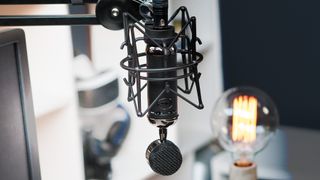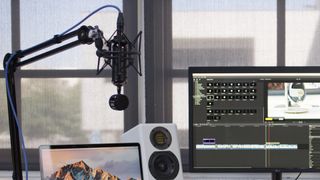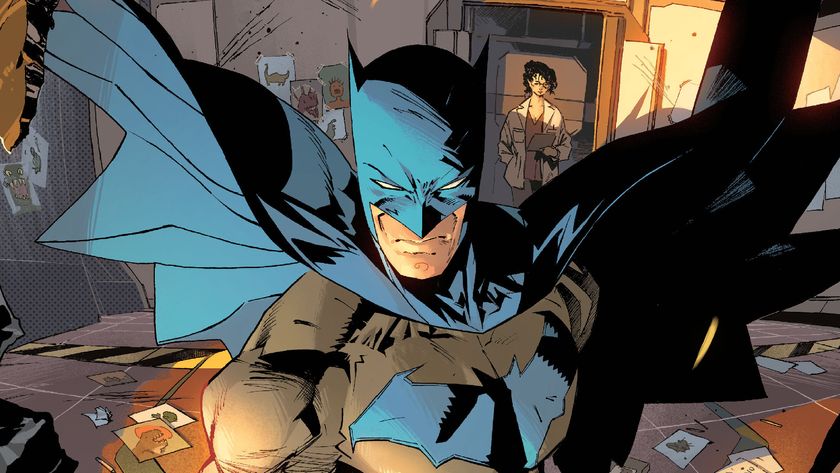12DOVE Verdict
Luxurious, exciting sound that at once manages to be both overkill and fantastic value.
Pros
- +
Studio-quality sound
- +
Low cut filter
- +
Extremely versatile condenser
Cons
- -
Requires audio interface & phantom power
Why you can trust 12DOVE
Blue is the last word in plug-in-and-forget players in the best microphone for streaming field and has been for as long as streaming’s even been an option for the masses. Many see its Yeti as the gold standard by which all other USB mics are judged, particularly since the inclusion of the Yeti X variant with slightly upscaled features versus its mainstream stablemate.
In the world of studio mics though, it’s a different story. Pro audio is a world of eq snobs and fastidious obsession with minor detail. And by necessity, too: studio gear is fantastically expensive, engineers are exacting, and musicians expectant. So how does Blue’s XLR studio condenser fare in an altogether different arena?
Design & Features
Blue has actually had this Spark SL mic on the market for a decade in various iterations, but with this Blackout edition we see not just a moody new aesthetic but also a 100Hz low cut and -20dB pad, both great for making on-the-fly changes in live recording environments and when using the mic to record different audio sources. You might deploy it as a vocal mic and then also as a drum overhead with the pad engaged, for example.
It’s worth noting that, being an XLR mic, you’ll need to run it through an audio interface in order to add it to your setup. We’re not talking about a vintage Neve console though, don’t worry - anything with an XLR input and phantom power will do the job, like Focusrite’s incredibly popular Scarlett interfaces, some of which you can pick up for well under $100/£100.

Presentation goes above and beyond what we’d expect from a streamer mic, and that’s exemplified by the wooden storage box it arrives in, but certainly not limited to it. The Blackout Spark XL’s unique look is formed by a large diaphragm capsule placed above the mic body itself, both finished to a luxurious standard. Within that body lies the class A-certified FET circuitry, which contributes to a really low noise mic.
Despite its fragile look, the capsule can hack up to 128dB of input, which is roughly equivalent to a chainsaw at operating distance, or two FIFA streamers opening FUT packs at 1m distance. Enough for your whispery meta-podcast about true crime, then.

Performance
We’re not sure who’d be surprised by this, but the Blackout Spark SL sounds absolutely delicious. Its tonal character is all about capturing a flat, natural sound which nonetheless flatters and enriches the performer in front of it. And it does so thanks to a slight eq dip in the mids, and an equally slight boost a little higher up the EQ spectrum in the space most of the human voice occupies - 1-2KHz. The result is a creaminess that sounds noticeably better than the Yeti X, for example, from the off.
The low cut works wonderfully to capture a vocal that sits proud in the mix and saves having to shave away unwanted frequencies with EQ plugins down the line. Outside of musical settings, spoken word recordings sound almost broadcast quality as soon as you lay them down. A touch of compression and they’re ready.
It probably goes without saying that this is all overkill for most streamers, podcasters, Discord gamers, and independent content creators, who are better served by a USB option that doesn’t need phantom power or an audio interface. But if for any reason you do want that extra fidelity a studio mic brings, the Blackout Spark SL’s an incredible value proposition at under £200/$200 which to this testers ears sounds comparable to AKG’s C414 in condenser mode. Granted, the latter features more polar patterns and a more detailed tonal character, but it’s also nearly $500/£500 pricier.

Overall - should you buy it?
A decade after the earliest Spark was released, Blue’s Blackout edition still impresses. The -20dB pad and low cut are both incredibly useful, and the sound simply can’t be argued with. It’s overkill for most gaming-related setups - that’s why the USB streamer mic market exploded in the first place! - but it’s also a fine ambassador of XLR studio mics for gamers who may be drawn by the Blue name to explore deeper into pro audio.
If you were to build any kind of streaming setup around this mic - be it a Razer streaming setup or otherwise - that features contenders for the best capture card, the best ring light, and the best green screen, and you will be laughing as it's incredibly worthy of being your centrepiece.
Phil Iwaniuk is a multi-faceted journalist, video producer, presenter, and reviewer. Specialising in PC hardware and gaming, he's written for publications including PCGamesN, PC Gamer, GamesRadar, The Guardian, Tom's Hardware, TechRadar, Eurogamer, Trusted Reviews, VG247, Yallo, IGN, and Rolling Stone, among others.

Reacher season 3 breaks a series record, landing a perfect Rotten Tomatoes score for the action show

A new Batman #1 from Matt Fraction and Jorge Jiménez launches this September with a "revamped aesthetic," a throwback costume, and a new Batmobile

Marvel reveals its full slate of May 2025 comics and covers featuring the Avengers, the X-Men, Spider-Man, and more
Most Popular





